- Clone
- IRF4.3E4 (See other available formats)
- Regulatory Status
- RUO
- Other Names
- Interferon regulatory factor 4
- Isotype
- Rat IgG1, κ
- Ave. Rating
- Submit a Review
- Product Citations
- publications
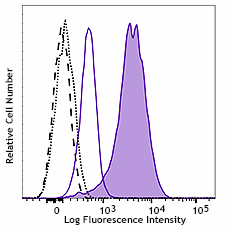
-

PHA-stimulated (3 days) or freshly isolated human peripheral blood lymphocytes were stained with CD4 APC, this fixed and permeabilized with True-Nuclear™ Transcription Factor Buffer Set (Cat. No. 424401). Cells were then stained with IRF4 (clone IRF4.3E4) PE (open histogram with solid line for fresh cells, filled histogram for stimulated cells) or rat IgG1, κ PE isotype control (dash line for fresh cell, dot line for stimulated cells). Data shown was gated on CD4+ lymphocyte population. -

Confocal image of human lymph node sample acquired using the IBEX method of highly multiplexed antibody-based imaging: CD31 (magenta) in Cycle 2, CD138 (blue) in Cycle 2, and IRF4 (green) in Cycle 6. Tissues were prepared using ~1% (vol/vol) formaldehyde and a detergent. Following fixation, samples are immersed in 30% (wt/vol) sucrose for cryoprotection. Images are courtesy of Drs. Andrea J. Radtke and Ronald N. Germain of the Center for Advanced Tissue Imaging (CAT-I) in the National Institute of Allergy and Infectious Diseases (NIAID, NIH).
| Cat # | Size | Price | Quantity Check Availability | Save | ||
|---|---|---|---|---|---|---|
| 646403 | 25 µg | $129 | ||||
| 646404 | 100 µg | $335 | ||||
The IRF family consists of at least nine members. IRF4 and IRF8 are highly homologous to each other and also redundant in function. IRF4 is critical for Th2 and Th17 development. Together with TRF8, it plays an essential role in macrophage and dendritic cell development and function. IRF4 is also reported to be essential for pre-B cell development, receptor editing, germinal center reactor and plasma cell differentiation.
Product DetailsProduct Details
- Verified Reactivity
- Mouse, Human
- Antibody Type
- Monoclonal
- Host Species
- Rat
- Immunogen
- GST fusion protein containing C-terminal of murine IRF4
- Formulation
- Phosphate-buffered solution, pH 7.2, containing 0.09% sodium azide.
- Preparation
- The antibody was purified by affinity chromatography and conjugated with PE under optimal conditions.
- Concentration
- 0.2 mg/ml
- Storage & Handling
- The antibody solution should be stored undiluted between 2°C and 8°C, and protected from prolonged exposure to light. Do not freeze.
- Application
-
ICFC - Quality tested
SB - Reported in the literature, not verified in house - Recommended Usage
-
Each lot of this antibody is quality control tested by intracellular immunofluorescent staining with flow cytometric analysis. For flow cytometric staining, the suggested use of this reagent is ≤0.25 µg per million cells in 100 µl volume. It is recommended that the reagent be titrated for optimal performance for each application.
- Excitation Laser
-
Blue Laser (488 nm)
Green Laser (532 nm)/Yellow-Green Laser (561 nm)
- Application Notes
-
Additional reported applications (for the relevant formats) include: spatial biology (IBEX)3,4.
- Additional Product Notes
-
Iterative Bleaching Extended multi-pleXity (IBEX) is a fluorescent imaging technique capable of highly-multiplexed spatial analysis. The method relies on cyclical bleaching of panels of fluorescent antibodies in order to image and analyze many markers over multiple cycles of staining, imaging, and, bleaching. It is a community-developed open-access method developed by the Center for Advanced Tissue Imaging (CAT-I) in the National Institute of Allergy and Infectious Diseases (NIAID, NIH).
-
Application References
(PubMed link indicates BioLegend citation) - Product Citations
-
- RRID
-
AB_2563004 (BioLegend Cat. No. 646403)
AB_2563004 (BioLegend Cat. No. 646404)
Antigen Details
- Structure
- Molecular weight is approximately 51 kD.
- Distribution
-
IRF4 is reported to be expressed exclusively in the immune system.
- Biology Area
- Cell Biology, Transcription Factors
- Molecular Family
- Nuclear Markers
- Antigen References
-
1. Lu R. 2008. Trends Immunol 29:487.
- Gene ID
- 3662 View all products for this Gene ID
- UniProt
- View information about IRF4 on UniProt.org
Related FAQs
- What type of PE do you use in your conjugates?
- We use R-PE in our conjugates.
- If an antibody clone has been previously successfully used in IBEX in one fluorescent format, will other antibody formats work as well?
-
It’s likely that other fluorophore conjugates to the same antibody clone will also be compatible with IBEX using the same sample fixation procedure. Ultimately a directly conjugated antibody’s utility in fluorescent imaging and IBEX may be specific to the sample and microscope being used in the experiment. Some antibody clone conjugates may perform better than others due to performance differences in non-specific binding, fluorophore brightness, and other biochemical properties unique to that conjugate.
- Will antibodies my lab is already using for fluorescent or chromogenic IHC work in IBEX?
-
Fundamentally, IBEX as a technique that works much in the same way as single antibody panels or single marker IF/IHC. If you’re already successfully using an antibody clone on a sample of interest, it is likely that clone will have utility in IBEX. It is expected some optimization and testing of different antibody fluorophore conjugates will be required to find a suitable format; however, legacy microscopy techniques like chromogenic IHC on fixed or frozen tissue is an excellent place to start looking for useful antibodies.
- Are other fluorophores compatible with IBEX?
-
Over 18 fluorescent formats have been screened for use in IBEX, however, it is likely that other fluorophores are able to be rapidly bleached in IBEX. If a fluorophore format is already suitable for your imaging platform it can be tested for compatibility in IBEX.
- The same antibody works in one tissue type but not another. What is happening?
-
Differences in tissue properties may impact both the ability of an antibody to bind its target specifically and impact the ability of a specific fluorophore conjugate to overcome the background fluorescent signal in a given tissue. Secondary stains, as well as testing multiple fluorescent conjugates of the same clone, may help to troubleshoot challenging targets or tissues. Using a reference control tissue may also give confidence in the specificity of your staining.
- How can I be sure the staining I’m seeing in my tissue is real?
-
In general, best practices for validating an antibody in traditional chromogenic or fluorescent IHC are applicable to IBEX. Please reference the Nature Methods review on antibody based multiplexed imaging for resources on validating antibodies for IBEX.
Other Formats
View All IRF4 Reagents Request Custom Conjugation| Description | Clone | Applications |
|---|---|---|
| Alexa Fluor® 488 anti-IRF4 | IRF4.3E4 | ICFC |
| Purified anti-IRF4 | IRF4.3E4 | WB,ICFC,ChIP |
| PE anti-IRF4 | IRF4.3E4 | ICFC,SB |
| Alexa Fluor® 647 anti-IRF4 | IRF4.3E4 | ICFC |
| PE/Cyanine7 anti-IRF4 | IRF4.3E4 | ICFC |
| PerCP/Cyanine5.5 anti-IRF4 | IRF4.3E4 | ICFC |
| Alexa Fluor® 594 anti-IRF4 | IRF4.3E4 | ICC |
| Pacific Blue™ anti-IRF4 | IRF4.3E4 | ICFC |
| TotalSeq™-B0249 anti-IRF4 Antibody | IRF4.3E4 | ICPG |
Customers Also Purchased
Compare Data Across All Formats
This data display is provided for general comparisons between formats.
Your actual data may vary due to variations in samples, target cells, instruments and their settings, staining conditions, and other factors.
If you need assistance with selecting the best format contact our expert technical support team.
-
Alexa Fluor® 488 anti-IRF4
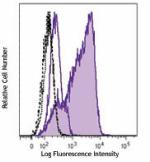
PHA-stimulated (3 days) or freshly isolated human peripheral... -
Purified anti-IRF4

Total lysates (15 µg protein) from HeLa (lane 1, negative co... 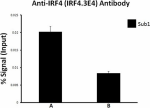
Chromatin Immunoprecipitation (ChIP) was performed using Go-... -
PE anti-IRF4
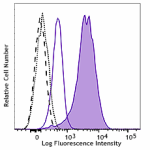
PHA-stimulated (3 days) or freshly isolated human peripheral... 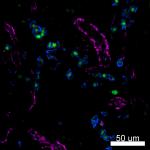
Confocal image of human lymph node sample acquired using the... -
Alexa Fluor® 647 anti-IRF4
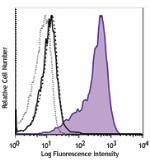
PHA-stimulated (3 days) or freshly isolated human peripheral... -
PE/Cyanine7 anti-IRF4
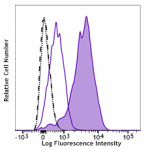
PHA-stimulated (3 days) or freshly isolated human peripheral... -
PerCP/Cyanine5.5 anti-IRF4
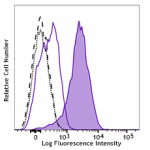
PHA-stimulated (3 days) or freshly isolated human peripheral... -
Alexa Fluor® 594 anti-IRF4
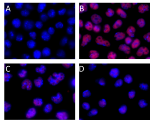
A20 cells were fixed with 4% paraformaldehyde (PFA) for 10 m... -
Pacific Blue™ anti-IRF4
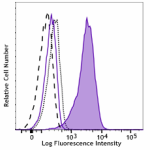
PHA-stimulated (3 days) or freshly isolated human peripheral... -
TotalSeq™-B0249 anti-IRF4 Antibody

 Login/Register
Login/Register 










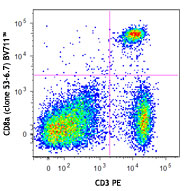
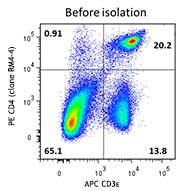
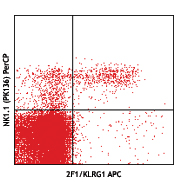



Follow Us